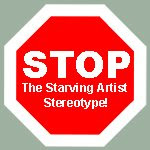Last week in the first post of the “Confessions” series, we talked about how a major common mistake of artists is to be discouraged by friends, family, and others. I received so many heartfelt responses from all of you, many who have also experienced similar challenges and I wanted to say how inspiring it was to know that we are not alone. We cannot underestimate the power of a simple vote of confidence. Inspire yourself and inspire one another.
This week, I’d like to talk about another common mistake I think many of us make: comfort zones. Or more specifically, not leaving our comfort zones.
In the last Confessions post, I talked about how sometimes college made me inject themes into my work that I did not feel were ‘me’. At the time, I really hated abstract art and thought of it as overpriced pieces of dribble made by people who could plop giant red dots on canvas, price it at a bajillion dollars, and call it art. Though I may express some bitterness over my college years, I can’t emphasize enough how this dissension and frustration was essential to making me a better artist.
I remember a conversation I had with one of my favorite art teachers at my college who constantly challenged me to ‘think outside the box’. I was working on a series of paintings to depict a dream sequence and instead of using figures, she challenged me to draw myself as an abstract shape.
“Why?” I asked. “No one will get that. I don’t get the point of that.” I ranted and raved and argued with that particular teacher so many times about why I thought abstraction was pointless and how I really loathed opaque painting. I missed my faithful color pencils and pens and my beloved tight detail. Now, I was forced into switching thinking modes, collaging leaves, and painting with less controllable media. All was chaos and new and I hated every minute of it back then. I went to bed angry and woke up frustrated.

It was not until I threw my arms in the air and decided that getting even was better than getting angry. I endeavored to make the most obscure abstract paintings I could. I threw myself into an effort to purposefully do the weirdest things I could think of with burnt paper, mod podge, broken glass, and mixed media. And somewhere along the line, I found I began to like it. I began to realize the reasoning behind some abstract artists where the process became more expressive than the final image, or that atmosphere was sometimes more jarring than an identifiable subject.
In the end, I left college with a successful senior exhibition that would not have been as immersive as it was if not for my teachers pushing me to get out of my comfort zone and try new things. I was able to combine sculpture work with paintings and mixed media in a truly strange dreamlike atmosphere that I would not have been able to achieve otherwise.
The most important thing I learned from these experiences at college was that every media has a life of its own and an asset it can add to a painting. Using and experimenting with various media is the only way to learn what works for you, personally, and how best to achieve the vision in your mind’s eye. If you never experiment, you will never grow. If you never challenge yourself, you will never improve.
Today, I find myself drifting back to color pencils and ink, but the years in school being ‘forced’ to experiment have given me a bravery in trying new things I never would have had before. Color Pencils and Ink have been happily joined by Watercolor and Digital in my repertoire.
To be sure, there are still comfort zones I need to venture out of. I do admit a propensity for drawing people over animals and for using traditional media. I’ve found I am particularly enjoying drawing birds and feathers recently and plan to one day revisit my obsession with drawing Siamese cats that I had when I was young. I also want to learn how to use oil paints and mix my own tempera like the Old Masters of yore. Ceramic molds have also been calling my name again as well. The search for an adequate kiln in my rustic town has yet to begin.
So much to explore, so little time!
Now it’s your turn. What do you wish you had experimented more with? What comfort zones have you been afraid to leave? Share and share alike.
